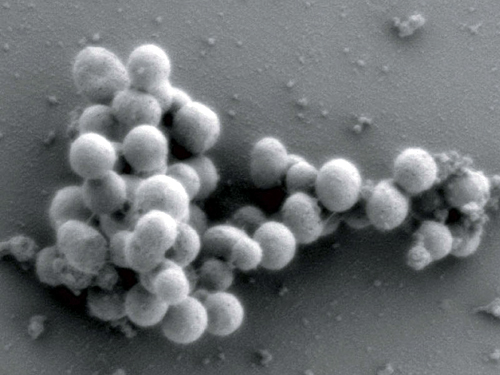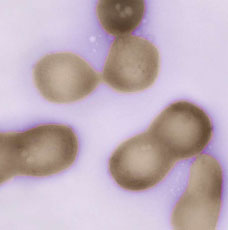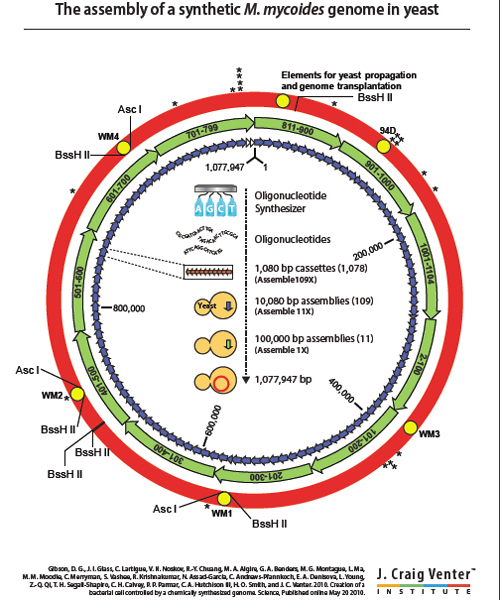|
This research will be published by Daniel Gibson et al in the May 20th edition of Science Express and will appear in an upcoming print issue of Science.
“For nearly 15 years Ham Smith, Clyde Hutchison and the rest of our team have been working toward this publication today--the successful completion of our work to construct a bacterial cell that is fully controlled by a synthetic genome,” said J. Craig Venter, Ph.D., founder and president, JCVI and senior author on the paper. “We have been consumed by this research, but we have also been equally focused on addressing the societal implications of what we believe will be one of the most powerful technologies and industrial drivers for societal good. We look forward to continued review and dialogue about the important applications of this work to ensure that it is used for the benefit of all.”
According to Dr. Smith, “With this first synthetic bacterial cell and the new tools and technologies we developed to successfully complete this project, we now have the means to dissect the genetic instruction set of a bacterial cell to see and understand how it really works."
To complete this final stage in the nearly 15 year process to construct and boot up a synthetic cell, JCVI scientists began with the accurate, digitized genome of the bacterium, M. mycoides. The team designed 1,078 specific cassettes of DNA that were 1,080 base pairs long. These cassettes were designed so that the ends of each DNA cassette overlapped each of its neighbors by 80bp. The cassettes were made according to JCVI’s specifications by the DNA synthesis company, Blue Heron Biotechnology.
|
The complete synthetic M. mycoides genome was isolated from the yeast cell and transplanted into Mycoplasma capricolum recipient cells that have had the genes for its restriction enzyme removed. The synthetic genome DNA was transcribed into messenger RNA, which in turn was translated into new proteins. The M. capricolum genome was either destroyed by M. mycoides restriction enzymes or was lost during cell replication. After two days viable M. mycoides cells, which contained only synthetic DNA, were clearly visible on petri dishes containing bacterial growth medium.
The initial synthesis of the synthetic genome did not result in any viable cells so the JCVI team developed an error correction method to test that each cassette they constructed was biologically functional. They did this by using a combination of 100 kb natural and synthetic segments of DNA to produce semi-synthetic genomes. This approach allowed for the testing of each synthetic segment in combination with 10 natural segments for their capacity to be transplanted and form new cells. Ten out of 11 synthetic fragments resulted in viable cells; therefore the team narrowed the issue down to a single 100 kb cassette. DNA sequencing revealed that a single base pair deletion in an essential gene was responsible for the unsuccessful transplants. Once this one base pair error was corrected, the first viable synthetic cell was produced.
|
This publication represents the construction of the largest synthetic molecule of a defined structure; the genome is almost double the size of the previous Mycoplasma genitalium synthesis. With this successful proof of principle, the group will now work on creating a minimal genome, which has been a goal since 1995. They will do this by whittling away at the synthetic genome and repeating transplantation experiments until no more genes can be disrupted and the genome is as small as possible. This minimal cell will be a platform for analyzing the function of every essential gene in a cell.
According to Dr. Hutchison, “To me the most remarkable thing about our synthetic cell is that its genome was designed in the computer and brought to life through chemical synthesis, without using any pieces of natural DNA. This involved developing many new and useful methods along the way. We have assembled an amazing group of scientists that have made this possible.”
|
The JCVI scientists envision that the knowledge gained by constructing this first self-replicating synthetic cell, coupled with decreasing costs for DNA synthesis, will give rise to wider use of this powerful technology. This will undoubtedly lead to the development of many important applications and products including biofuels, vaccines, pharmaceuticals, clean water and food products. The group continues to drive and support ethical discussion and review to ensure a positive outcome for society.
Funding for this research came from Synthetic Genomics Inc., a company co-founded by Drs. Venter and Smith.
Note: See Craig's TED presentation of February 2008, On the Verge of Creating Synthetic Life.
Background
The research published today was made possible by previous breakthroughs at JCVI. In 2007 the team published results from the transplantation of the native M. mycoides genome into the M. capricolum cell which resulted in the M. capricolum cell being transformed into M. mycoides. This work established the notion that DNA is the software of life and that DNA dictates the cell phenotype.
In 2008 the same team reported on the construction of the first synthetic bacterial genome by assembling DNA fragments made from the four chemicals of life—ACGT. The final assembly of DNA fragments into the whole genome was performed in yeast by making use of the yeast genetic systems. However, when the team attempted to transplant the synthetic bacterial genome out of yeast and into a recipient bacterial cell, viable transplants could not be recovered.
Ethical Considerations: Since the beginning of the quest to understand and build a synthetic genome, Dr. Venter and his team have been concerned with the societal issues surrounding the work. In 1995 while the team was doing the research on the minimal genome, the work underwent significant ethical review by a panel of experts at the University of Pennsylvania (Cho et al, Science December 1999:Vol. 286. no. 5447, pp. 2087 – 2090). The bioethical group's independent deliberations, published at the same time as the scientific minimal genome research, resulted in a unanimous decision that there were no strong ethical reasons why the work should not continue as long as the scientists involved continued to engage public discussion.
Dr. Venter and the team at JCVI continue to work with bioethicists, outside policy groups, legislative members and staff, and the public to encourage discussion and understanding about the societal implications of their work and the field of synthetic genomics generally. As such, the JCVI’s policy team, along with the Center for Strategic & International Studies (CSIS), and the Massachusetts Institute of Technology (MIT), were funded by a grant from the Alfred P. Sloan Foundation for a 20-month study that explored the risks and benefits of this emerging technology, as well as possible safeguards to prevent abuse, including bioterrorism. After several workshops and public sessions the group published a report in October 2007 outlining options for the field and its researchers.
Most recently in December of 2008, JCVI received funding from the Alfred P. Sloan Foundation to examine ethical and societal concerns that are associated with the developing science of synthetic genomics. The ongoing research is intended to inform the scientific community as well as educate our policymakers and journalists so that they may engage in informed discussions on the topic.
J. Craig Venter Institute



